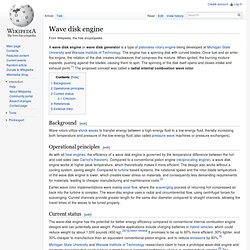

PiechnaAkbariIancuMuellerIMECE2004-59022. Michigan State University Receives $2.5M ARPA-E Award to Build Wave Disc Engine/Generator for Series Hybrid Applications. Michigan State University Receives $2.5M ARPA-E Award to Build Wave Disc Engine/Generator for Series Hybrid Applications Researchers from Michigan State University have been awarded $2.5 million from the Department of Energy’s ARPA-E program (earlier post) to complete its prototype development of a new gasoline-fueled wave disc engine and electricity generator that promises to be five times more efficient than traditional auto engines in electricity production, 20% lighter, and 30% cheaper to manufacture.

The wave disc engine, a new implementation of wave rotor technology, was earlier developed by the Michigan State group in collaboration with researchers from the Warsaw Institute of Technology. About the size of a large cooking pot, the novel, hyper-efficient engine could replace current engine/generator technologies for plug-in hybrid electric vehicles. LinkClick. New engine shakes up auto industry - Technology & science - Innovation. Despite shifting into higher gear within the consumer's green conscience, hybrid vehicles are still tethered to the gas pump via a fuel-thirsty 100-year-old invention: the internal combustion engine.

However, researchers at Michigan State University have built a prototype gasoline engine that requires no transmission, crankshaft, pistons, valves, fuel compression, cooling systems or fluids. Their so-called Wave Disk Generator could greatly improve the efficiency of gas-electric hybrid automobiles and potentially decrease auto emissions up to 90 percent when compared with conventional combustion engines. The engine has a rotor that's equipped with wave-like channels that trap and mix oxygen and fuel as the rotor spins. Wave disk engine. A wave disk engine or wave disk generator is a type of pistonless rotary engine being developed at Michigan State University and Warsaw Institute of Technology.

The engine has a spinning disk with curved blades. Once fuel and air enter the engine, the rotation of the disk creates shockwaves that compress the mixture. When ignited, the burning mixture expands, pushing against the blades, causing them to spin. The spinning of the disk itself opens and closes intake and exhaust ports.[1] The proposed concept was called a radial internal combustion wave rotor.